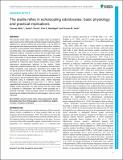Files in this item
The startle reflex in echolocating odontocetes : basic physiology and practical implications
Item metadata
| dc.contributor.author | Götz, Thomas | |
| dc.contributor.author | Pacini, Aude F. | |
| dc.contributor.author | Nachtigall, Paul | |
| dc.contributor.author | Janik, Vincent M. | |
| dc.date.accessioned | 2020-03-13T16:30:01Z | |
| dc.date.available | 2020-03-13T16:30:01Z | |
| dc.date.issued | 2020-03-12 | |
| dc.identifier | 262037582 | |
| dc.identifier | 7b8da864-de5e-4817-9c18-6e4403360e63 | |
| dc.identifier | 85081924852 | |
| dc.identifier | 000541826200003 | |
| dc.identifier.citation | Götz , T , Pacini , A F , Nachtigall , P & Janik , V M 2020 , ' The startle reflex in echolocating odontocetes : basic physiology and practical implications ' , Journal of Experimental Biology , vol. 223 , jeb208470 . https://doi.org/10.1242/jeb.208470 | en |
| dc.identifier.issn | 0022-0949 | |
| dc.identifier.other | ORCID: /0000-0001-7894-0121/work/70619130 | |
| dc.identifier.other | ORCID: /0000-0002-4630-3328/work/71221491 | |
| dc.identifier.uri | https://hdl.handle.net/10023/19655 | |
| dc.description | This study was funded by Marine Scotland (Scottish Government). Open Access funding provided by The University of St Andrews. | en |
| dc.description.abstract | The acoustic startle reflex is an oligo-synaptic reflex arc elicited by rapid-onset sounds. Odontocetes evolved a range of specific auditory adaptations to aquatic hearing and echolocation, e.g. the ability to downregulate their auditory sensitivity when emitting clicks. However, it remains unclear whether these adaptations also led to changes of the startle reflex. We investigated reactions to startling sounds in two bottlenose dolphins (Tursiops truncatus) and one false killer whale (Pseudorca crassidens). Animals were exposed to 50 ms, 1/3 octave band noise pulses of varying levels at frequencies of 1, 10, 25 and 32 kHz while positioned in a hoop station. Startle responses were quantified by measuring rapid muscle contractions using a three-dimensional accelerometer attached to the dolphin. Startle magnitude increased exponentially with increasing received levels. Startle thresholds were frequency dependent and ranged from 131 dB at 32 kHz to 153 dB at 1 kHz (re. 1 µPa). Startle thresholds only exceeded masked auditory AEP thresholds of the animals by 47 dB but were ∼82 dB above published behavioural audiograms for these species. We also tested the effect of stimulus rise time on startle magnitude using a broadband noise pulse. Startle responses decreased with increasing rise times from 2 to 100 ms. Models suggested that rise times of 141–220 ms were necessary to completely mitigate startle responses. Our data showed that the startle reflex is conserved in odontocetes and follows similar principles as in terrestrial mammals. These principles should be considered when assessing and mitigating the effects of anthropogenic noise on marine mammals. | |
| dc.format.extent | 12 | |
| dc.format.extent | 1128805 | |
| dc.language.iso | eng | |
| dc.relation.ispartof | Journal of Experimental Biology | en |
| dc.subject | Acoustic startle reflex | en |
| dc.subject | Hearing thresholds | en |
| dc.subject | Startle thresholds | en |
| dc.subject | Rise time | en |
| dc.subject | Anthropogenic noise | en |
| dc.subject | Bottlenose dolphin | en |
| dc.subject | Tursiops | en |
| dc.subject | Pseudorca | en |
| dc.subject | Brainstem | en |
| dc.subject | QH301 Biology | en |
| dc.subject | DAS | en |
| dc.subject | SDG 14 - Life Below Water | en |
| dc.subject.lcc | QH301 | en |
| dc.title | The startle reflex in echolocating odontocetes : basic physiology and practical implications | en |
| dc.type | Journal article | en |
| dc.contributor.institution | University of St Andrews. Sea Mammal Research Unit | en |
| dc.contributor.institution | University of St Andrews. Scottish Oceans Institute | en |
| dc.contributor.institution | University of St Andrews. School of Biology | en |
| dc.contributor.institution | University of St Andrews. Marine Alliance for Science & Technology Scotland | en |
| dc.contributor.institution | University of St Andrews. Institute of Behavioural and Neural Sciences | en |
| dc.contributor.institution | University of St Andrews. Centre for Social Learning & Cognitive Evolution | en |
| dc.contributor.institution | University of St Andrews. Bioacoustics group | en |
| dc.identifier.doi | https://doi.org/10.1242/jeb.208470 | |
| dc.description.status | Peer reviewed | en |
This item appears in the following Collection(s)
Items in the St Andrews Research Repository are protected by copyright, with all rights reserved, unless otherwise indicated.

